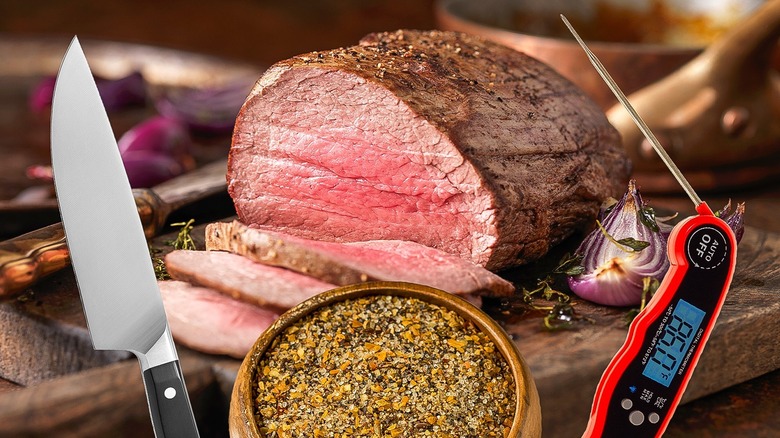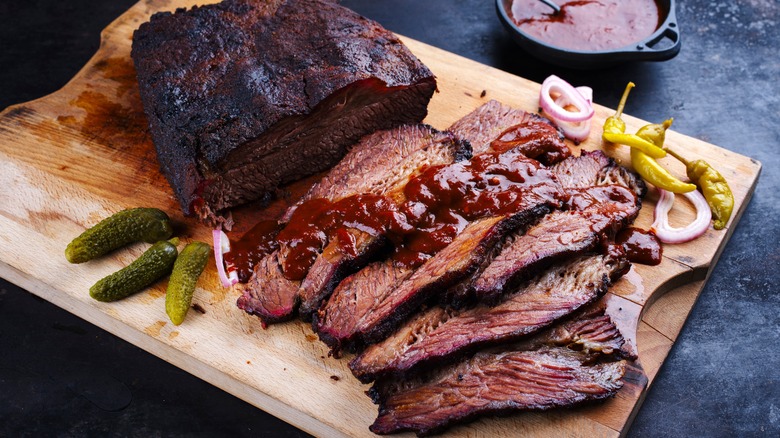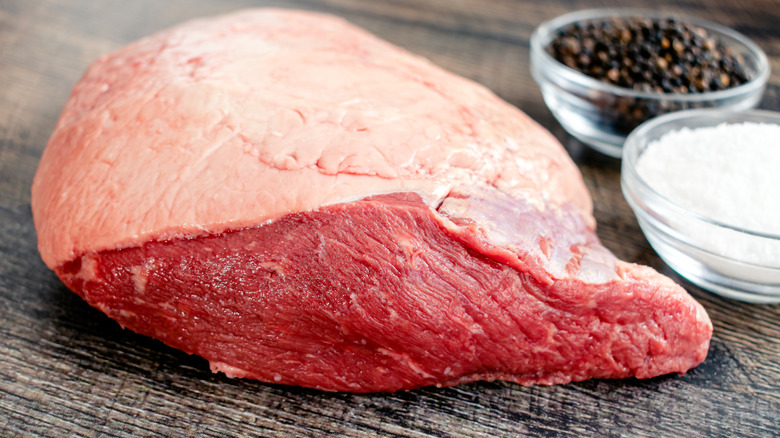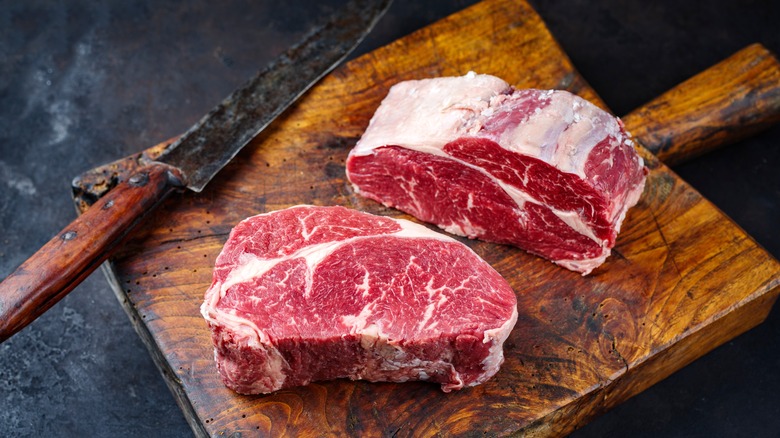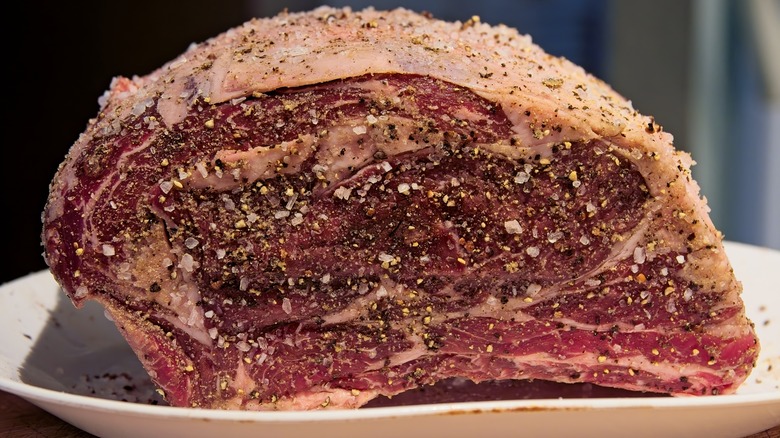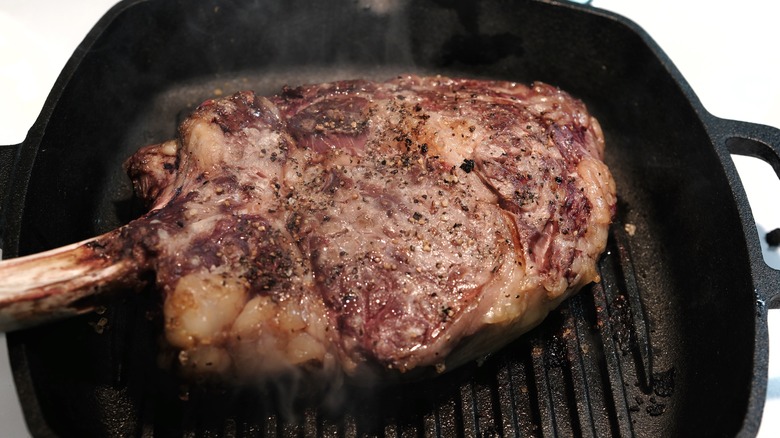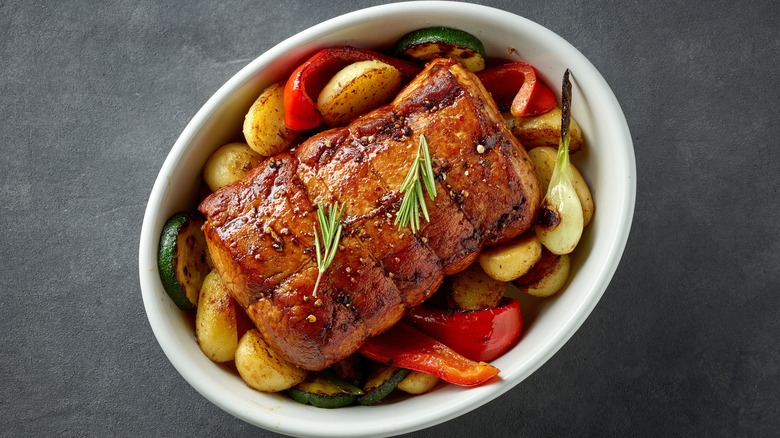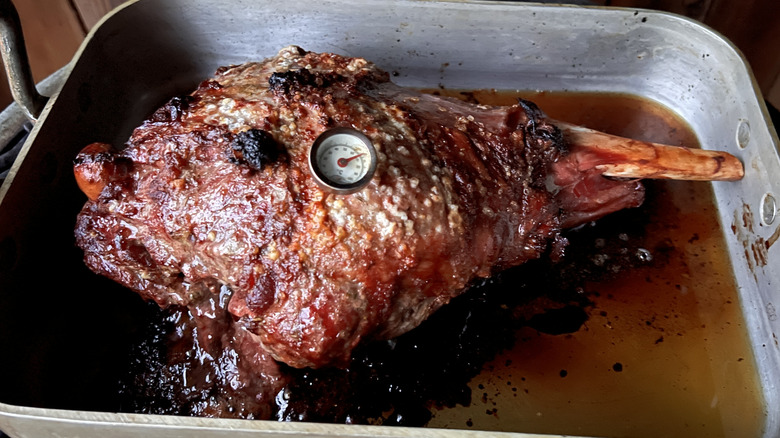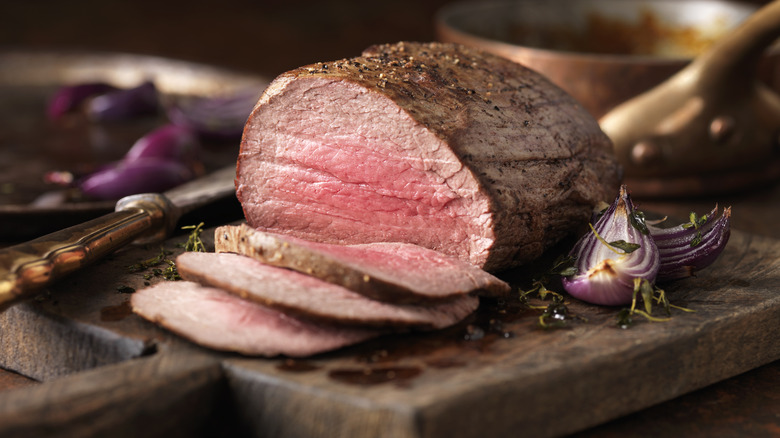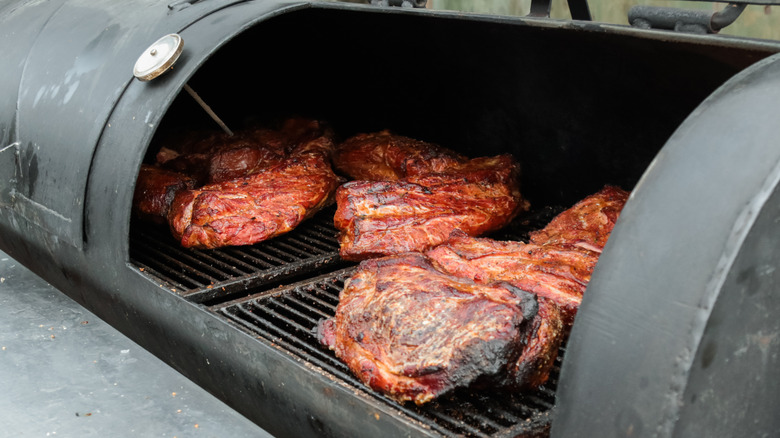9 Mistakes Everyone Makes When Roasting Thick Cuts Of Meat
From chuck beef to pork shoulder to leg of lamb, thick cuts of meat can seem a little intimidating if you're not sure how to cook them. Roasting is one of the most popular ways to cook thicker cuts of meat in order to end up with juicy, tender protein. But there are also a handful of mistakes that can be made along the way, from prep to finish, which may result in a less-than-stellar piece of meat. Because of this, I reached out to Douglas Keane, chef at the Michelin-starred Cyrus Restaurant in Geyserville, CA, to learn more about roasting thick cuts of meat. If it's your first time or your 10th time tackling a large chunk of meat, Keane, also a chef at Two Birds/One Stone, a yakitori restaurant, has meaty tips for all cooks, from beginners to experts.
It all begins with the meat itself. Whether you source a pork loin or lamb shoulder, Keane tells us, "Cuts with a bone are ideal for roasting." Bone-in roasts are often easier to handle, remain intact while cooking, and create a better braising broth. "I particularly love working with large cuts like beef striploin and ribeye," Keane confides. If you can't find a thick cut of meat with the bone still in, boneless meat that's been trussed is also an option.
Avoiding tougher cuts of meat
You might think you need to stay away from tougher pieces of meat in order to achieve perfectly roasted thick cuts. But tougher cuts can be good candidates when it comes to roasting. "While cuts like shanks are better suited for braising, they can be slow roasted with excellent results," Douglas Keane informs us. "In general, any cut of meat can be roasted, though tougher cuts benefit from added moisture to create a bit of steam." This added moisture helps the roast from becoming too dry from a long cook time, as well as aids in breaking down all of the connective tissue found in tougher, working muscles.
Certainly, you can source a more tender cut of meat, such as prime rib or rack of lamb, but if budget is a concern, don't be afraid to reach for more affordable cuts like beef chuck, brisket, or lamb shoulder, which happen to be tougher in nature. Either way, know which type of meat you have and how it will benefit from roasting, says Keane. "For example, a pork shoulder can be slow-roasted effectively, but adding a little liquid to the pan helps enhance the texture. In contrast, a pork loin roast doesn't require any added liquid during roasting."
Not preparing the roast correctly
It would be a mistake to remove your thick cut of meat from the fridge or freezer and immediately toss it in the oven or skillet. For best results, fully thaw your roast in the refrigerator, which could take a couple of days. Before cooking it, meat should be brought to room temperature — a process referred to as tempering. This is done so the meat stands the best chance at getting a succulent sear on the exterior and so the interior cooks more evenly. Just note that per the USDA, perishable foods should not be left for more than two hours at room temperature, and meat should not be thawed on the counter to prevent foodborne illness.
Understanding which type of cut you have helps determine how best to prepare it. Chef Douglas Keane tells us that while it's not necessary to purposefully tenderize large cuts of meat, you may want to add a little salt or acid to your roast, depending on the cut's tenderness level. "If it's a luxury, tender cut, I simply prefer to salt the meat," Keane says. "Basically, 1% salt to the weight of the meat." As for what type of salt to use, Kosher salt is a popular choice for salting meat as part of preparation. Otherwise, Keane says, "Tougher cuts like tri-tips, flanks, and shoulders benefit from marinades with salt and acid in them to help denature the muscle."
Leaving an uneven roast whole
Thick cuts of meat come in various shapes and sizes, depending on the animal, the location the cut comes from, and the butcher who does the processing. You may find a photo-worthy, perfectly shaped roast or one that's an uneven, odd-shaped lump in your grocer's case, but they will cook differently. Sourcing a thick cut of meat that's the same from one end to the other is preferable for roasting it the right way. "If the roast is unevenly shaped, it will not cook evenly," warns chef Douglas Keane. These types of cuts are great for mincing and slow cooking.
If you have to hunt high and low for that perfect-looking roast, consider slicing an uneven piece of meat into individual steaks. Keane tells us, "For even cooking, cut the roast into smaller, more uniform pieces," especially if you want or need to shorten your cooking time. But if all you can find is an odd-shaped piece of meat, no worries; it's still good for roasting whole. It just won't cook evenly from end to end.
Dismissing additional seasoning
After you have prepped your thick cut of meat correctly, don't forget to add seasoning before or during cooking to give your meat a deeper flavor. Even if you're just looking to enhance meat's natural richness, methods like dry brining or marinating can take a large piece of meat and bring it to another level. Chef Douglas Keane explains, "Dry brining, seasoning, and marinating are all excellent ways to enhance the flavor of large cuts." He notes that they're all "great ways to get seasoning into a big piece."
Tougher cuts of meat benefit greatly from dry brining, which requires a large amount of salt that's sprinkled liberally on the outside of your thick cut. The method means letting it sit for a few hours so the meat pulls the salt in and retains moisture, which, in turn, seasons the meat, makes it more tender, and dries out the surface. A drier surface makes for a better sear. Alternatively, you can use an acidic marinade, suggests Keane. "I like marinades for things like tri-tip because they help break down the tougher parts of the muscle," he says.
Not taking advantage of searing your meat
There are two ways to sear your meat: at the start of cooking and at the end of cooking. When it's accomplished at the end of cooking, it's considered a reverse sear. Either way, you're missing out on the wonderful effects of the Maillard reaction if you don't take advantage of searing your large cut of meat when roasting it. Chef Douglas Keane says, "The best method for roasting thick cuts of meat is to start with a high heat to sear the exterior, then lower the temperature to slow and low cooking."
Once your thick cut of meat comes to room temperature and is properly prepared and seasoned, searing it creates a natural outer crust that not only tastes delicious but also helps the meat retain its moisture while it cooks. Keane explains the best way to sear a large cut. "[Use a] very hot pan or grill," he says. "[Then,] hard sear [a] small amount of fat if [it's] in a pan on the stovetop." Use an oil or fat with a high smoke point to keep the fat from burning due to the high heat. However, if you're searing on a grill, Keane tells us not to use added fat with a live flame.
Covering the roast while cooking
A common mistake when cooking a thick cut of meat is covering it during roasting. Chef Douglas Keane tells us this isn't necessary for achieving a juicy piece of meat. When you cover the meat while it's cooking, the cover traps the rising steam, circulating it back into the meat, effectively steaming it instead of roasting it. This changes the outcome of the meat and ruins the sear that created your crispy crust. This is also why basting isn't necessary either and can actually be detrimental to that seared exterior.
There are only a couple of times when you want to cover your meat during roasting, according to chef Keane, and one of those times is if there's a lot of sugar in the marinade or seasoning. Sugar caramelizes when it comes into contact with heat, which can enhance your sear, but it's also at risk of burning from a high temperature or long cook. Additionally, if your roast is extra large, upward of 8 pounds or more, you may need to cover it for a little bit to keep it from drying out during a lengthy cook time.
Neglecting to use a meat thermometer
One of the trickiest parts of roasting a thick cut of meat is determining when it's done. A basic formula for roasting meat includes an average amount of time per pound of meat cooked at a certain temperature. While this rough range can give you an idea of how long your meat will be in the oven, it doesn't give you a specific time for when it will be done cooking. That amount of time also changes depending on the type of meat you're cooking and how you want it cooked — rare, medium rare, medium, or well done.
If you're a more experienced cook, you may be able to tell when your roast is done just by feel, but chef Douglas Keane says, "The best way to determine if a thick roast is done is by using a thermometer." A meat thermometer can tell you what the internal temperature is in the deepest part of the meat. Then, you can be sure to hit the safe minimum temperature for the type of meat you're roasting, as well as aim for your desired doneness for meat like beef and lamb, which have various doneness levels. The thermometer comes in handy since meat continues to cook after it's pulled from the heat. "For example," chef Keane says, "if your target temperature is 135 degrees Fahrenheit, remove the meat from the heat at 120 to 125 degrees Fahrenheit, allowing it to come to temperature while resting."
Slicing the roast right away after cooking
The most common mistake, according to chef Douglas Keane, that people make when trying to roast a thick cut of meat is not being patient enough during the entire process. It's not just prepping, seasoning, and cooking that creates the best roast. "The No. 1 mistake," Keane remarks, "is not allowing it to rest long enough after cooking." Resting your meat plays a large role in the overall success of the end result. Letting your meat hang around after you've taken it off the heat allows it to finish cooking and redistribute its internal juices. Resting ensures that when you cut into the meat, the added moisture doesn't run all over your plate.
Chef Keane recommends resting your roast for no less than 15 minutes, even for cuts that weigh less than a pound. Keep in mind, he says, "Depending on the size of the cut, it may need up to an hour of resting time." Cover your roast during this time to promote moist and tender meat. If the roast cools off too much while it rests, Keane suggests rewarming it before serving.
Not experimenting with various roasting methods
Challenge yourself. If most of these tips are simple for you, don't become stagnant in your culinary skills. It would be a shame and mistake to stop learning. Branch out, experiment, says chef Douglas Keane. "Try different temperatures and times," he suggests. Try different methods. "Start on high and then reduce to low or start very low and get your 'sear' at the end by raising the heat significantly," Keane says. Compare the two methods and make note of the differences you find. Keane tells us, "Research a few different options on temperature and time and experiment and see what works best."
You just might find your favorite way by attempting to use a smoker rather than a grill, or a grill rather than your oven. You may also find some cuts of meat, be it pork, lamb, venison, or beef, just react differently (for better or worse) depending on the cooking method and variation used. For example, Keane mentions, "Low and slow will usually be a safe bet for most tougher cuts, but some proteins break down at higher temps and need the cooking time shortened."
